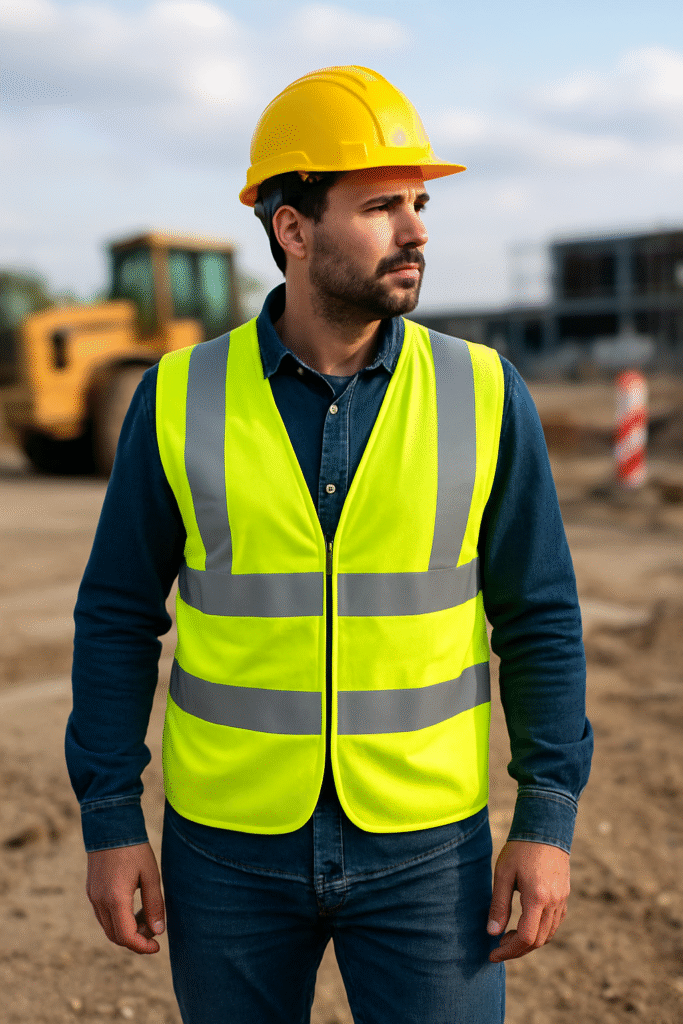In industries like construction, logistics, and roadwork, where workers operate near heavy machinery or moving vehicles, visibility is not just a safety precaution, it’s a matter of life and death. High-visibility workwear, especially Safety Vest, plays a crucial role in ensuring that workers stand out in any environment, whether it’s broad daylight, low light, or poor weather conditions. However, not all safety vests are created equal. The effectiveness of a hi-vis vest depends significantly on its design, material, and fit.

Why Design Matters in Hi-Vis Vests
The primary purpose of a safety vest is to make the wearer visible from all angles. That visibility largely depends on its design elements, such as color contrast, reflective material placement, and pattern layout. Modern designs combine bright fluorescent fabrics typically neon yellow, orange, or green — with strategically placed reflective tapes that reflect light from headlights or machinery.
According to the ANSI/ISEA 107-2020 Standard, these reflective and background materials must meet specific brightness and visibility requirements. A properly designed vest ensures that the reflective areas create a human silhouette, making the wearer instantly recognizable to others, even in motion.
Poorly designed safety vests often lack sufficient reflective coverage or use materials that degrade quickly after washing or exposure to sunlight. This compromises worker safety, especially in high-risk environments. On the other hand, professional-grade vests like those from JK Safety are designed with durability, visibility, and ergonomic comfort in mind meeting the highest ansi 107 standard benchmarks.
Fit: The Often Overlooked Safety Factor
Even the most reflective vest loses its effectiveness if it doesn’t fit properly. A vest that’s too loose can snag on equipment, while one that’s too tight can restrict movement or ride up, exposing non-reflective areas of clothing. Both scenarios can reduce visibility and comfort, increasing the risk of accidents.
The best high-visibility workwear takes fit into account with adjustable closures, breathable fabrics, and ergonomic cuts that accommodate layering during different seasons. Workers should be able to move freely without the vest shifting out of position. When a vest fits correctly, reflective strips stay aligned with the body, maintaining consistent visibility regardless of movement.
Design Innovations Improving Performance
Recent innovations in safety vest design have focused on combining high visibility with comfort and practicality. Features like lightweight mesh fabrics improve airflow, while reinforced pockets and ID holders add functionality. Some modern vests even integrate LED lights or smart reflective fibers that adjust brightness based on lighting conditions.
In addition, manufacturers are increasingly tailoring vests to specific job types for example:
- Surveyor vests with extra pockets for tools and documents.
- Public safety vests with breakaway features to prevent snagging.
- Utility vests for electricians and technicians, designed for maximum mobility.
Each design element serves a purpose, ensuring that safety vests don’t just meet the standard — they enhance worker performance and comfort.
The Role of Material Quality
Material choice directly affects both visibility and comfort. Premium polyester or mesh blends provide durability and breathability, ensuring that the vest performs well under heat, rain, or dust. Reflective materials, often made with micro-glass beads or prismatic films, determine how effectively light bounces back toward the source.
Cheap, low-grade materials may fade quickly or lose reflectivity after a few washes. This degradation can make workers less visible especially in dawn or dusk conditions. That’s why investing in high visibility workwear made from certified materials is essential for maintaining consistent protection over time.
Compliance with Safety Standards
The ANSI/ISEA 107-2020 standard categorizes high-visibility garments into performance classes (Class 1, 2, and 3) based on the amount of reflective and fluorescent material used.
- Class 1 is suitable for low-risk environments, such as parking attendants or warehouse staff.
- Class 2 offers higher visibility and is ideal for roadside workers or airport ground crews.
- Class 3 provides maximum visibility for those working in high-speed traffic zones or low-light conditions.
Employers must assess job hazards and ensure that workers wear the appropriate class of safety vest. Non-compliance not only puts employees at risk but can also lead to fines or liability in case of an accident.
Comfort Enhances Safety
A comfortable vest is one that workers are more likely to wear consistently. Features like breathable mesh, lightweight design, and adjustable waistbands enhance comfort without sacrificing safety. Many modern vests incorporate moisture-wicking technology to keep workers dry, which is especially beneficial in hot environments.
Comfort directly correlates with compliance. If workers find their vests restrictive or uncomfortable, they might remove them during shifts, defeating the purpose of wearing one in the first place.
Environmental Considerations and Sustainability
As the world becomes more environmentally conscious, the safety gear industry is following suit. Sustainable high-visibility workwear made from recycled polyester and eco-friendly dyes is now gaining traction. These materials offer the same performance as traditional options but with a smaller carbon footprint.
Sustainable design not only benefits the environment but also aligns with corporate social responsibility goals, appealing to eco-conscious companies and workers alike.
Final Thoughts
The effectiveness of a high-visibility vest goes beyond just its color or reflectivity. The design, material, and fit collectively determine how well it performs in real-world working conditions. Employers and safety officers should look for vests that meet or exceed the ansi 107 standard, ensuring both compliance and comfort for their teams.
Whether you’re a construction worker, road safety officer, or warehouse staff, choosing the right vest can make all the difference between staying safe or being overlooked in a hazardous environment.
To explore premium-quality options designed for safety, comfort, and durability, check out the range of Safety Vest and other high visibility workwear at JK Safety where innovation meets protection.

